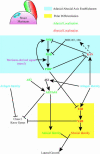Promoter bashing, microRNAs, and Knox genes. New insights, regulators, and targets-of-regulation in the establishment of lateral organ polarity in Arabidopsis
- PMID: 15208415
- PMCID: PMC514105
- DOI: 10.1104/pp.104.040394
Promoter bashing, microRNAs, and Knox genes. New insights, regulators, and targets-of-regulation in the establishment of lateral organ polarity in Arabidopsis
Figures



Similar articles
-
The ARGONAUTE10 gene modulates shoot apical meristem maintenance and establishment of leaf polarity by repressing miR165/166 in Arabidopsis.Plant J. 2009 Apr;58(1):27-40. doi: 10.1111/j.1365-313X.2008.03757.x. Epub 2008 Dec 29. Plant J. 2009. PMID: 19054365
-
VAAMANA--a BEL1-like homeodomain protein, interacts with KNOX proteins BP and STM and regulates inflorescence stem growth in Arabidopsis.Gene. 2004 Mar 17;328:103-11. doi: 10.1016/j.gene.2003.12.033. Gene. 2004. PMID: 15019989
-
Maize rough sheath2 and its Arabidopsis orthologue ASYMMETRIC LEAVES1 interact with HIRA, a predicted histone chaperone, to maintain knox gene silencing and determinacy during organogenesis.Plant Cell. 2005 Nov;17(11):2886-98. doi: 10.1105/tpc.105.035477. Epub 2005 Oct 21. Plant Cell. 2005. PMID: 16243907 Free PMC article.
-
A KNOX family TALE.Curr Opin Plant Biol. 2009 Oct;12(5):593-8. doi: 10.1016/j.pbi.2009.06.006. Epub 2009 Jul 23. Curr Opin Plant Biol. 2009. PMID: 19632142 Review.
-
Plant development: Two sides to organ asymmetry.Curr Biol. 2001 Sep 18;11(18):R756-8. doi: 10.1016/s0960-9822(01)00440-7. Curr Biol. 2001. PMID: 11566122 Review.
Cited by
-
Maintenance of stem cell activity in plant development and stress responses.Front Plant Sci. 2023 Dec 12;14:1302046. doi: 10.3389/fpls.2023.1302046. eCollection 2023. Front Plant Sci. 2023. PMID: 38155857 Free PMC article. Review.
-
The Putative RNA-dependent RNA polymerase RDR6 acts synergistically with ASYMMETRIC LEAVES1 and 2 to repress BREVIPEDICELLUS and MicroRNA165/166 in Arabidopsis leaf development.Plant Cell. 2005 Aug;17(8):2157-71. doi: 10.1105/tpc.105.033449. Epub 2005 Jul 8. Plant Cell. 2005. PMID: 16006579 Free PMC article.
-
Shoot meristem function and leaf polarity: the role of class III HD-ZIP genes.PLoS Genet. 2006 Jun;2(6):e89. doi: 10.1371/journal.pgen.0020089. PLoS Genet. 2006. PMID: 16846251 Free PMC article. Review.
-
The Bsister MADS gene FST determines ovule patterning and development of the zygotic embryo and endosperm.PLoS One. 2013;8(3):e58748. doi: 10.1371/journal.pone.0058748. Epub 2013 Mar 19. PLoS One. 2013. PMID: 23527017 Free PMC article.
-
Patterns of MADS-box gene expression mark flower-type development in Gerbera hybrida (Asteraceae).BMC Plant Biol. 2006 Jun 9;6:11. doi: 10.1186/1471-2229-6-11. BMC Plant Biol. 2006. PMID: 16762082 Free PMC article.
References
-
- Bollman KM, Aukerman MJ, Park M, Hunter C, Berardini TZ, Poethig RS (2003) Hasty, the Arabidopsis ortholog of exportin 5/MSN5, regulates phase change and morphogenesis. Development 130: 1493–1504 - PubMed
-
- Bowman J, Eshed Y, Baum SF (2002) Establishment of polarity in angiosperm lateral organs. Trends Genet 18: 134–141 - PubMed
-
- Bowman JL, Smyth DR (1999) CRABS CLAW, a gene that regulates carpel and nectary development in Arabidopsis, encodes a novel protein with zinc finger and helix-loop-helix domains. Development 126: 2387–2396 - PubMed
Publication types
MeSH terms
Substances
LinkOut - more resources
Full Text Sources
Other Literature Sources

